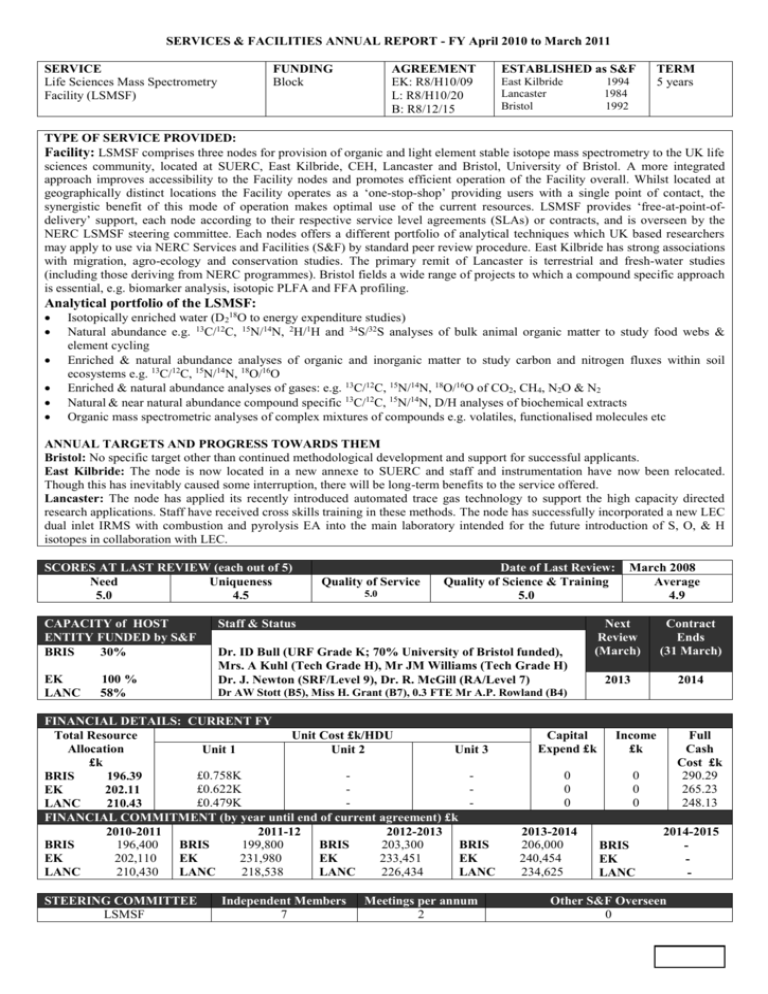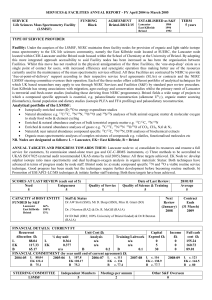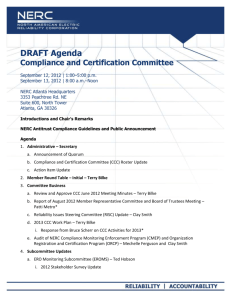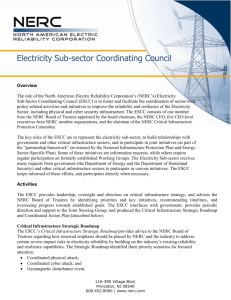LSMSF annual report 2010-2011
advertisement

SERVICES & FACILITIES ANNUAL REPORT - FY April 2010 to March 2011 SERVICE Life Sciences Mass Spectrometry Facility (LSMSF) FUNDING Block AGREEMENT EK: R8/H10/09 L: R8/H10/20 B: R8/12/15 ESTABLISHED as S&F East Kilbride Lancaster Bristol 1994 1984 1992 TERM 5 years TYPE OF SERVICE PROVIDED: Facility: LSMSF comprises three nodes for provision of organic and light element stable isotope mass spectrometry to the UK life sciences community, located at SUERC, East Kilbride, CEH, Lancaster and Bristol, University of Bristol. A more integrated approach improves accessibility to the Facility nodes and promotes efficient operation of the Facility overall. Whilst located at geographically distinct locations the Facility operates as a ‘one-stop-shop’ providing users with a single point of contact, the synergistic benefit of this mode of operation makes optimal use of the current resources. LSMSF provides ‘free-at-point-ofdelivery’ support, each node according to their respective service level agreements (SLAs) or contracts, and is overseen by the NERC LSMSF steering committee. Each nodes offers a different portfolio of analytical techniques which UK based researchers may apply to use via NERC Services and Facilities (S&F) by standard peer review procedure. East Kilbride has strong associations with migration, agro-ecology and conservation studies. The primary remit of Lancaster is terrestrial and fresh-water studies (including those deriving from NERC programmes). Bristol fields a wide range of projects to which a compound specific approach is essential, e.g. biomarker analysis, isotopic PLFA and FFA profiling. Analytical portfolio of the LSMSF: Isotopically enriched water (D218O to energy expenditure studies) Natural abundance e.g. 13C/12C, 15N/14N, 2H/1H and 34S/32S analyses of bulk animal organic matter to study food webs & element cycling Enriched & natural abundance analyses of organic and inorganic matter to study carbon and nitrogen fluxes within soil ecosystems e.g. 13C/12C, 15N/14N, 18O/16O Enriched & natural abundance analyses of gases: e.g. 13C/12C, 15N/14N, 18O/16O of CO2, CH4, N2O & N2 Natural & near natural abundance compound specific 13C/12C, 15N/14N, D/H analyses of biochemical extracts Organic mass spectrometric analyses of complex mixtures of compounds e.g. volatiles, functionalised molecules etc ANNUAL TARGETS AND PROGRESS TOWARDS THEM Bristol: No specific target other than continued methodological development and support for successful applicants. East Kilbride: The node is now located in a new annexe to SUERC and staff and instrumentation have now been relocated. Though this has inevitably caused some interruption, there will be long-term benefits to the service offered. Lancaster: The node has applied its recently introduced automated trace gas technology to support the high capacity directed research applications. Staff have received cross skills training in these methods. The node has successfully incorporated a new LEC dual inlet IRMS with combustion and pyrolysis EA into the main laboratory intended for the future introduction of S, O, & H isotopes in collaboration with LEC. SCORES AT LAST REVIEW (each out of 5) Need Uniqueness 5.0 4.5 CAPACITY of HOST ENTITY FUNDED by S&F BRIS 30% EK LANC 100 % 58% Quality of Service 5.0 Date of Last Review: Quality of Science & Training 5.0 Staff & Status Dr. ID Bull (URF Grade K; 70% University of Bristol funded), Mrs. A Kuhl (Tech Grade H), Mr JM Williams (Tech Grade H) Dr. J. Newton (SRF/Level 9), Dr. R. McGill (RA/Level 7) Next Review (March) Contract Ends (31 March) 2013 2014 Dr AW Stott (B5), Miss H. Grant (B7), 0.3 FTE Mr A.P. Rowland (B4) FINANCIAL DETAILS: CURRENT FY Total Resource Unit Cost £k/HDU Allocation Unit 1 Unit 2 Unit 3 £k £0.758K BRIS 196.39 £0.622K EK 202.11 £0.479K LANC 210.43 FINANCIAL COMMITMENT (by year until end of current agreement) £k 2010-2011 2011-12 2012-2013 BRIS 196,400 BRIS 199,800 BRIS 203,300 BRIS EK 202,110 EK 231,980 EK 233,451 EK LANC 210,430 LANC 218,538 LANC 226,434 LANC STEERING COMMITTEE LSMSF March 2008 Average 4.9 Independent Members 7 Meetings per annum 2 Capital Expend £k Income £k 0 0 0 0 0 0 Full Cash Cost £k 290.29 265.23 248.13 BRIS EK LANC 2014-2015 - 2013-2014 206,000 240,454 234,625 Other S&F Overseen 0 APPLICATIONS: DISTRIBUTION OF GRADES (current FY — 2010-2011) R*/Pilot Reject 5 4 3 2 1 NERC Grant projects* 0 4.5 0 0 0 0 1 0 Other academic 1 4 1 1 0 0 0 3 Students 0 3 4 0 0 0 0 0 Pilot 0 0 0 0 0 0 0 0 2 13.5 5 1 0 0 2 4 TOTAL APPLICATIONS: DISTRIBUTION OF GRADES (per annum average previous 3 financial years —2007/2008, 2008/2009 & 2009/2010) R*/Pilot Reject 5 4 3 2 1 NERC Grant projects* 0.33 4.49 0.33 0 0 0 1 0 Other Academic 0 8 0.67 1 0 0 3.66 1.66 Students 0 4 2 0.67 0 0.33 3.33 0.33 Pilot 0 0 0 0 0 0 0.33 0 0.33 16.49 3 1.67 0 0 8.32 2 TOTAL PROJECTS COMPLETED (current FY – 2010/11) 5 NERC Grant projects* 1 Other Academic 0 Students 0 Pilot 0 4 2.5 5 6.5 0 3 1 0 5 0 2 0 0 0 0 1 0 0 0 0 0 0 0 0 R*/Pilot 1 0 2 0 Project Funding Type (current FY – 2010/11) (select one category for each project) Infrastructure PAYG Grand Student Student NERC NERC Total Supplement to NERC Grant * Other C/S Grant* NERC Other NERC Other 57 12 16 8 4 17 0 0 0 Project Funding Type (per annum average previous 3 financial years - 2007/2008, 2008/2009 & 2009/2010) Infrastructure PAYG Grand Student Student NERC NERC Total Supplement to NERC Grant * Other C/S Grant* NERC Other NERC Other 52.3 7 9.33 12.67 3.33 20 0 0 0 User type (current FY – 2010/11) (include each person named on application form) Academic Centre/Survey NERC Fellows 16.5 10 1 User type (per annum average previous 3 financial years - 2007/2008, 2008/2009 & 2009/2010) Academic Centre/Survey NERC Fellows 27 3.33 0.66 2.67 14 Grand Total 52.33 Other 0 NERC C/S 0 Other 0 PhD 23.5 Commercial 0 PhD 21.33 Commercial 0 OUTPUT & PERFORMANCE MEASURES (current year) Publications (by science area & type) (calendar year 2010) SBA ES MS AS TFS EO Polar Grand Total Refereed Non-Ref/ Conf Proc 3 0.83 19.84 2 21 0 1.33 48 25 16 Distribution of Projects (by science areas) (FY 2010/11 Grand Total SBA ES MS AS TFS EO 57 8.5 0 15.5 1 30 0 OUTPUT & PERFORMANCE MEASURES (per annum average previous 3 years) Publications (by science area & type) (Calendar years 2007, 2008 & 2009) SBA ES MS AS TFS EO Polar Grand Total Refereed Non-Ref/ Conf Proc 2 NERC C/S 0 1 22 0 0.66 42.33 21.33 14.33 Distribution of Projects (by science areas) (FY 2007/2008, 2008/2009 & 2009/2010) SBA ES MS AS TFS EO 2.5 1.33 19.33 1.67 25 0 Distribution of Projects by NERC strategic priority (current FY 2010/11) PhD Theses 7 Polar 2 PhD Theses 6.67 Polar 2.5 Grand Total Climate System Biodiversity Earth System Science Sustainable Use of Natural Resources Natural Hazards Environment, Pollution & Human Health Technologies 57 8.76 31.08 7 3.58 0 5.58 1 *Combined Responsive Mode and Directed Programme grants NOTE: All metrics should be presented as whole or part of whole number NOT as a % OVERVIEW & ACTIVITIES IN FINANCIAL YEAR (2010/2011): Bristol: This has been an industrious period for the Bristol node which has provided support for 16 research projects over the course of the year. Whilst the number of new applications (5) received in this period was lower than anticipated it is also somewhat serendipitous. There is currently a large commitment to several outstanding applications that have either been waiting for delivery of results utilising newly developed techniques (e.g. lsmsfbris035_cameron) or have taken longer than anticipated to deliver large sets of samples for analysis (e.g. lsmsfbris029_ashmore). Combined with more recent applications, the 2011-2012 period promises to be no less busy. Nevertheless, the node needs to increase its profile to the NERC community and this shall be addressed in the ensuing period (see below). OPMs of high quality continue to be produced by Facility staff and users alike (9) and we anticipate an increase in such outputs as the effect of the larger nodal capacity is slowly realised in the form of publications and other outputs. Instrument performance over the last year has been generally good with the only notable exceptions being substantial downtime of the PyGC/MS instrumentation (CDS 5150 Pyroprobe and PerkinElmer Turbomass Gold GC/MS) and one of the GC/C/IRMS instruments (Finnigan MAT Delta S) dedicated to compound specific 13C value determinations. The former is still being repaired whilst the latter of these two instruments is now operational although given its age at 20+ years it is likely that this instrument shall need to be replaced in the short to medium term future. The node has continued to invest time in developing and applying new methodologies in conjunction with the Organic Geochemistry Unit at Bristol. Substantial progress has been made in the areas of 15N value determination of amino acids and 13C value determination of amino acids by LC-IRMS; the former is already being adopted by the community. Mrs A Kuhl represented the Bristol node at a ThermoElectron customer feedback meeting in Edinburgh and has continued to supply opinions and experiences as part of the company’s ‘ThermoCares’ initiative. Dr ID Bull attended the 2010 meeting of the British Organic Geochemistry Society in Manchester. Moreover, Dr Bull has accepted a position on the board of the Forensic Isotope Ratio Mass Spectrometry (FIRMS) network and shall be seeking, amongst other things, to use the position to the increase the reliability of compound specific stable isotope analyses between laboratories. NERC LSMSF shall be a leading player in this endeavour. The Facility director, Professor RP Evershed was awarded the BMSS Aston Medal and elected a Fellow of the Royal Society. East Kilbride: A busy year for the node, having received 18 applications of which 13 were funded, and we completed measurements for 12 projects. One of the major changes was the plan by SUERC to invest in new premises for both the node and the Isotope Community Support Facility, annexed to the main SUERC building. The design and logistics of this was largely overseen by the LSMSF-EK Manager, and we were able to move the mass spectrometers over to the new laboratory shortly before Christmas so that they could “settle in” over the holidays. This has of course resulted in some interruption to service, but our laboratory space has doubled, such that more effective training and instrument development is possible for the future. Both mass spectrometers have lost only a month of downtime. Also, we have been developing a reactor for use in measuring carbon and nitrogen isotope ratios in smaller samples. Tests show that it is suitable for running samples of median size 0.25 mg, as opposed to 0.7 mg for the usual apparatus. It is being used for a project which involves stable isotope measurements of single insects. Non-capital investment has been made for the carbonate option for our Gas Bench II, which will enable carbon and oxygen isotope analysis of carbonates, and we also have a replacement freeze dryer. Lancaster 2010-2011 has been a year of high activity for the Lancaster node with all available SF & T capacity utilised by 13 different LSMSFSC approved projects, 2 of which were alpha 5 and 11 of which were alpha 4 grade. It is notable that 9 of the 13 projects originated from NERC blue skies and directed research programmes, with the remaining 4 resourced from Non NERC applications. The high number of applications received from NERC grant award holders confirms the crucial role played by the Lancaster node in supporting the NERC’s own scientific user community and underpinning NERC science itself. Moreover, the wealth of active ‘high grade’, high capacity, research projects carried out by Lancaster clearly demonstrates the exceptional quality of the science that the node is currently supporting. The nodes analytical portfolio varied considerably this year but spanned across three major NERC Science areas, namely: Terrestrial & Freshwater, Marine & Atmosphere. Five new applications to the node were received this reporting year and were graded by the LSMSFSC as follows: 1 x 5, 3 x 4 and 1 x R. The last two quarters of the year were extremely productive with the Phase II summer samples entering the node from two large Ecology & Hydrology Funding Initiative grants and the culmination of a large ‘blue skies’ grant from York University. Careful coordination of sample submission times, combined with automated trace gas analysis prevented analytical bottle necks during this busy period. Instrument downtime has been minimal during the year with only two minor ‘quick fix’ incidents occurring. The collaborative venture between LEC and CEH to accommodate the £150,000 SRIF funded dual inlet Isoprime 100 and Elementar Vario Pyrocube C/N/S/O/H analyser in the LSMSF lab came to fruition in October 2010. The liquid auto-sampler for O/H analyses of waters has just been commissioned in January 2011. Prior to the installation, the main laboratory refurbishment started on 7th to 17th June and was carefully co-ordinated to minimize disruption to the working laboratory. The existing Airedale air conditioning unit was decommissioned and 2 new Mitsubishi ceiling mounted air conditioning units were fitted costing LEC £10K. Better temperature control of the main instrument laboratory is already evident through monthly monitoring of the environmental conditions in the room. New benching was installed as well as extraction hoods for toxic gases (SO2, CO) and electronic CO, SO2 and H2 detector systems were installed in the room as part of the nodes commitment to high standards of Health and Safety. The IRMS is being operated by a LEC appointed technician who will work to our UKAS quality assurance standard, which, incidentally has just recently been successfully audited for the sixth consecutive year. The future objectives of the node will be to introduce S/O/H technology into the remit of the Lancaster node with the intention to offer these techniques to the NERC community as routine procedures. e.g. critical load sulphur deposition in soils, plant leaf carbon/oxygen analyses for water use efficiency projects or H/O analysis of ground waters. This will undoubtedly add further to the key analytical strengths, expertise and uniqueness status of the LSMSF as a whole. Peer reviewed publications attributable to support provided from the node for the same period amounted to four with at least six more currently submitted and under review. CAPITAL INVESTMENT Bristol: The node had not anticipated making a capital bid in the 2010-2011 reporting period. However, following catastrophic failure of a pyrolysis autosampler unit, funds for a replacement were requested and granted (£21,320). The funding enabled the broken pyrolyser autosampler (CDS 2500 Pyrolysis Unit) to be replaced with a less complicated manual unit (CDS Pyroprobe 5150). The reasoning behind selecting a manual replacement was two-fold: (1) the initial cost of the unit is considerably cheaper than that of the autosampler as is the cost of routine consumables, and (2) the manual system is more robust and more likely to provide a much longer service life than the corresponding autosampler unit. The CDS Pyroprobe 5150 will be used in conjunction with a dedicated GC/MS system already maintained by the Facility. The funding requested included full installation and training with the new system. East Kilbride: No capital requested. Lancaster: No capital was requested from SF & T during this reporting year. However, Dr Stott has been key figure in the nodes strategic plan to incorporate a new state-of-the-art LEC dual inlet isotope ratio mass spectrometer into the nodes main instrument laboratory. This in effect has potentially saved NERC SF & T and CEH’s capital equipment budget £150,000 which otherwise would have been required in future to develop this technology at Lancaster. Thus three new isotopes will be introduced into the Lancaster laboratory: oxygen, sulphur and hydrogen. The development of these isotopes undoubtedly has the potential to integrate LEC isotope science into CEH and has already brought in new contacts, new science ideas and new opportunities to take forward into the future. The uniqueness status of the LSMSF Lancaster node may thus be further enhanced for the next NERC Service Review. SCIENCE HIGHLIGHTS: Bristol: A particularly exciting aspect of the work recently conducted by the Bristol node has been its involvement with the development and validation of the new IP25 (Ice Proxy with 25 carbon atoms) with researchers at the University of Plymouth. This has resulted in several publications the most recent of which published in Polar Biology on 30 th January 2010. IP25 is based upon a C25 highly branched isoprenoid (HBI, Fig. 1) that appears to be produced selectively by Arctic sea ice diatoms and is structurally distinct from other HBIs. This has led the Plymouth group to hypothesise that its detection in marine sediments had the potential to provide proxy evidence for historical sea ice occurrence. The validity of IP25 as such a proxy still requires further testing. Therefore, the purpose of the current study was to identify: (1) the timing of IP 25 production in Arctic sea ice, (2) the vertical distribution of IP25 within sea ice, (3) the relationship between the production of IP25 and other commonly occurring biomarkers (fatty acids, sterols and chlorophyll a) in order to gain further insights into the significance of this biomarker as a proxy for spring Arctic sea ice. Compound specific 13C values determined for fatty acids in the upper 6–7 cm ice section of a core (D38) where the brine volume fraction was 5% and the fatty acid concentrations were very low, yielded values (13C = 28.3‰) that reflected this low productivity. In contrast, for sections where fatty acid concentrations were much higher, the more positive 13C values, especially in the 1–4 cm ice sections, indicated relatively lower 13C depletion consistent with a CO2-limited environment. Exceptionally, in the lowest 0–1 cm ice section, where fatty acid concentrations were highest, the lower 13C values indicatedbiosynthesis under relatively CO2-rich conditions that exist via replenishment from the ocean. Therefore, stable isotope measurements support the suggestion that some fatty acids detected in sea ice samples originated from allochthonous sources, as previously mentioned, especially in the lowestice core sections. These results helped provide further evidence that IP 25 is synthesised by Arctic sea ice diatoms during thespring bloom. Furthermore, the identification of a main production interval from mid-March to end of May in first-year sea ice will help to improve future interpretations of the sedimentary abundance of IP 25 in palaeo sea ice reconstructions. Brown, T.A., Belt, S.T., Philippe, B., Mundy, C.J., Massé, G., Poulin, M. and Gosselin, M. 2010. Temporal and vertical variations of lipid biomarkers during a bottom ice diatom bloom in the Canadian Beaufort Sea: further evidence for the use of IP25 biomarker as a proxy for spring Artic sea ice. Polar Biology DOI 10.1007/s00300-10-0942-5. Collaboration between the Facility Manager, Dr Ian Bull, and a research team based at the University of St Andrews and led by Professor Michael Bird has generated a particularly noteworthy publication in the Proceedings of the National Academy of Sciences (of the United States of America). During the Last Glacial Period (LGP; 125– 10 kiloyear [kyr] ago), particularly the Last Glacial Maximum (LGM; 23–19 kyr ago), reduced global sea level exposed the continental shelf from south of Thailand to Sumatra, Java, and Borneo, revealing thecontiguous continent Sundaland, with a land area the size of Europe. It has been hypothesized that forest was replaced by savanna over large areas or, alternatively, that lowland tropical rainforest persisted despite any reduction in rainfall. Surprisingly, there are no records from peninsular Malaysia and, in places where LGM sediments with suitable proxies are recovered, they may be compromised by biases such as riparian gallery forest vegetation and wind-blown tree pollen dominating riverine and offshore deposits, or lowland swamp regions being biased toward indicating wetter conditions. Hence, even the general distribution of LGM vegetation is disputed. 13C values of n-alkanes extracted from stratified deposits of bat guano depositied in Makangit Cave circumvented contamination effects from lithogenic carbon (that rendered bulk 13C values unreliable, Fig. 2). This helped provide evidence in support of the hypothesis that a substantial area of savanna covered Sundaland north of the equator, potentially facilitating human dispersal through the region. Wurster, C.M., Bird, M.I., Bull, I. D., Creed, F., Bryant, C., Dungait, J.A.J. and Paz, V. 2010. Forest contraction in north equatorial Southeast Asia during the Last Glacial Period. Procedings of the National Academy of Sciences 107, 15508-15511. East Kilbride A study published in Nature on the 6th of January has investigated the community ecology behind the co-existence of many closely-related catfish species in the rivers of South America. The fundamental reason is that, despite their surficial similarities, largely they do not compete for food. This mimicry may help to avoid predation, in that if all catfish in one region use similar warning patterns, then predators will learn to avoid them, which benefits all catfish. However it was not initially apparent why so many catfish mimics could exist in a small area. The researchers concluded that it is their dietary preferences, that allow so many species to coexist in a small area. The work was led by the University of Bangor and involved researchers from the Universidade Estadual Paulista, Brazil, and LSMSF-EK. Stable isotope expertise provided by the node was crucial in understanding the dietary requirements of the different species. Alexandrou M.A., Oliveira C., Maillard M., McGill R.A.R., Newton J., Creer S. and Taylor M.I. (2011). Competition and phylogeny determine community structure in Müllerian co-mimics. Nature 469, 84-88. This investigation has also been highlighted by NERC’s Planet Earth. Lancaster: Dr LF Dong, a research fellow from the University of Essex has recently published the findings of a study conducted in collaboration with a multi disciplinary team of researchers from the University of South Pacific (Fiji), the University of Sheffield, Bogor Agricultural University (Indonesia), Mahidol International College (Thailand) and the LSMSF Lancaster. The study measured benthic denitrification and dissimilatory reduction of nitrate to ammonium using the isotope-pairing technique in three tropical estuaries in Thailand (Mae Klong), Indonesia (Cisadane), and Fiji (Vunidawa-Rewa) during rainy, dry, and intermediate seasons along the salinity gradient of each estuary. Dissimilatory reduction of nitrate to ammonium dominated. It was shown Anammox (AN) was measured initially but neither AN activity nor AN bacteria–related 16S ribosomal RNA genes were detected in any of the estuaries. Denitrification was either zero or extremely low, driven by water column nitrate and not from benthic nitrification– denitrification. Interestingly N2O was not formed during denitrification. N2O saturations in estuary water were low, except in the nutrified Indonesian estuary, and tropical estuaries are therefore likely to be only small sources of N2O. Benthic nitrate reduction was nitrate limited; when nitrate was enhanced experimentally, denitrification increased slightly, but dissimilatory reduction of nitrate to ammonium increased proportionately much more. Predominance of dissimilatory reduction of nitrate to ammonium over denitrification in tropical estuaries may be due both to an energetic advantage (greater standard free energy change, DGu) of nitrate ammonifiers over denitrifiers when competing for limited nitrate, and also to higher affinity for nitrate by the nitrate ammonifiers. At tropical temperatures the three processes occur in the order DNRA . denitrification . AN. In contrast, temperate estuaries, at lower temperature and higher nitrate concentrations, exhibit proportionately greater levels of AN and denitrification. The Cisadane estuary became anoxic during the dry season, with high ammonium and sulfide, but no nitrate reduction because of lack of nitrate. Addition of nitrate stimulated high rates of autotrophic enitrification driven by sulfide, but not dissimilatory reduction of nitrate to ammonium. Dissimilatory reduction of nitrate to ammonium, not denitrification or anammox, dominates benthic nitrate reduction in tropical estuaries. Liang F. Dong, Milika Naqasima Sobey, Cindy J. Smith, Iman Rusmana, Wayne Phillips, Andrew Stott, A. Mark Osborn and David B. Nedwell (2011) Limnol. Oceanogr., 56(1), 2011, 279–291. FUTURE DEVELOPMENTS/STRATEGIC FORWARD LOOK Bristol: No major developments or changes are anticipated for Bristol over the 2011-2012 period. The node shall continue to refine the new methodologies that it has developed and/or offers, e.g. compound specific D and 15N value determination, 13C value determination of amino acids using LC/IRMS, determination of TEX86 and BIT indices, SPME-GC/MS etc., answering uptake by users whilst continuing to provide analytical support required for more routine methodologies requested by other on-going projects. Accordingly the node has made a modest request for capital funding (£15,800) which it shall use to purchase replacement turbomolecular pumps that shall help ensure the continued operation of the majority of mass spectrometers housed by the node. Efforts to raise the profile of the node with the NERC shall continue through a number of initiatives, including: promotion at relevant meetings, an improved web presence and mailshots to NERC grantholders. In addition, following discussion with managers from East Kilbride and Lancaster, the node shall be play a central role in the organisation of a conference, to be held sometime in 2012, that shall showcase NERC LSMSF science and bring together, past, present and future users with the aim of raising the overall profile of the whole Facility. It is also planned that the 2011-2012 period shall also provide further training opportunities, for facility staff, in GC/MS, LC/MS and EA/IRMS. This shall be achieved through a combination of private sector and inter-nodal training courses/activities. East Kilbride: Technique development will be mainly restricted to perfecting small-sample measurements of 15N and 13C in organic samples, and redeveloping sulphur isotope analysis of organic samples. However, with the purchase of the carbonate option for the Gas Bench II, we expect that some time will also be put aside to ensuring that a new protocol for measuring 13C and 18O in carbonate samples is developed. No large capital bid is expected next year. Lancaster: As already mentioned the future aim is for the LSMSF Lancaster node staff to augment their skills portfolio in dual inlet O, H, S techniques to eventually be in a foremost position offer these new innovations to both ‘in house’ and the external user community. It is the intention of the node staff to enhance their knowledge base from 2011 onwards to enable them to operate the new instrument. Automated methane methods coupled with improvements of methane combustion is an area of trace gas technological development which the node would like to explore. Both would aim to be a resource saving formula. Automation would free up staff resources, whilst the more efficient combustion at lower temperatures using Palladium reactors would reduce the inherent time it takes to optimise the instrument for methane analysis. The node aims to ensure that more scientists and students working within the UK’s NERC Science remit are aware of the existence of the node, its activities, remit, expertise and analytical portfolio. One mechanism by which this message can be carried forward is via conferences. SIMSUG 2011, in November 2011, will thus be jointly hosted by LEC and the LSMSF node (CEH) with a pre conference one day user group meeting for Isoprime IRMS and Elementar users.







